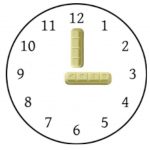Yellow School Bus Xanax: Meaning, Uses, Side Effects, Addiction

What is School Bus Xanax?
School Bus Xanax is a yellow rectangle-shaped generic brand of alprazolam with the imprint R 0 3 9, it is supplied by Actavis and contains 2 mg of the active ingredient. School Bus Xanax bar which can be broken into 4 pieces of 0.5 milligrams each works by enhancing the activity of certain neurotransmitters in the brain. The slang School Bus Xanax is widely used as a street name for the drug because its color and shape look similar to the American school bus.
The drug is prescribed for the treatment of anxiety disorders and anxiety caused by depression. School Bus Xanax is also used to treat panic disorders with or without a fear of places and situations that might cause panic, helplessness, or embarrassment (agoraphobia).
School Bus Xanax is a federally controlled substance (C-IV) because it can be abused or lead to dependence. It is not safe to purchase School Bus 2mg yellow Xanax bar from unauthorized vendors located outside the United States. The medicine you are buying from dubious sites may contain harmful ingredients or may not come from a licensed pharmacy. It would help if you remembered that Xanax’s sale and distribution outside the United States do not comply with the FDA regulations to use this drug safely.
How should School Bus Xanax be used?
School Bus Xanax comes as a 2mg bar to take by mouth. Follow the directions on your prescription label carefully, and ask your doctor or pharmacist to explain any part you do not understand. Take alprazolam exactly as directed.
Typical dosing for alprazolam
- Anxiety Disorders: The typical starting dose is 0.25 mg to 0.5 mg three times a day.
- Panic Disorder: The typical starting dose is 0.5 mg to 1 mg once daily. Your provider might change your dose based on how you respond to the starting dose.
Your doctor will probably start you on a low dose of alprazolam and gradually increase your dose, not more than once every 3 or 4 days.
How long does it take for School Bus Xanax to kick in?
School Bus Xanax is taken by mouth and is readily absorbed into the bloodstream. You should start feeling the effects of School Bus Xanax in under an hour. The medication reaches peak concentrations in the bloodstream in one to two hours following ingestion.
People who take School Bus Xanax will often build up a tolerance. For these people, it may take longer to feel the sedative effects of School Bus Xanax or the sedation may not feel as strong.
What does School Bus Xanax feel like if you’re using it recreationally?
Many people who take School Bus Xanax recreationally, or without a prescription, describe the feeling as sedating or calming.
Unlike some drugs, such as cocaine, that produce a “high” or euphoric feeling, School Bus Xanax users describe feeling more relaxed, quiet, and tired. These feelings may lead to falling asleep or passing out for a few hours.
Some people have also reported memory loss or blacking out and not remembering what happened for several hours. Higher doses will have stronger effects.
What are the side effects of School Bus Xanax?
Side effects often occur at the beginning of School Bus Xanax therapy and will usually disappear when a person stops taking the medication.
Some possible side effects of School Bus Xanax include:
• a dry mouth or increased saliva
• abnormal dreams
• abnormal involuntary movement
• anxiety
• blurred vision
• chest pain
• confusion
• confusion
• constipation or diarrhea
• decreased libido
• depression
• dizziness
• drowsiness
• edema
• fainting
• fear
• headache
• hyperventilation
• hypotension
• impaired coordination
• incontinence
• increased libido
• increased or decreased appetite
• inflammation of the skin due to allergy
• insomnia
• irritability
• lightheadedness
• low energy
• memory impairment
• menstrual disorders
• muscle twitching and cramps
• nasal congestion
• nausea and vomiting
• nervousness
• rash
• restlessness
• rigidity
• slurred speech
• sweating
• tachycardia or heart palpitations
• tinnitus
• tremor
• upper respiratory infection
• weakness
• weight gain or loss
The above is not a complete list of side effects, and others may occur. Call a doctor for medical advice about side effects. People can also report any Xanax side effects they experience to the FDA at 800-332-1088.
A person needs emergency medical help if they have any of these symptoms of an allergic reaction to School Bus Xanax:
• hives
• difficulty breathing
• swelling of the face, lips, tongue, or throat
A person should call their doctor at once if they have a serious side effect such as:
• depressed mood, thoughts of suicide or hurting oneself, unusual risk-taking behaviors, decreased inhibitions, or no fear of danger
• confusion, hyperactivity, agitation, hostility, or hallucinations
• feeling very faint
• urinating less than usual or not at all
• chest pain, a pounding heartbeat, or a fluttering feeling in the chest
• uncontrolled muscle movements, tremors, or seizures
• jaundice, or yellowing of the skin or eyes

What are the risks associated with abusing School Bus Xanax?
When people abuse a School Bus Xanax for a long stretch of time, the brain starts to forget how to operate effectively in its absence. School Bus Xanax harnesses control over emotional responses, thought processes, memory, consciousness, and even muscular coordination. All benzodiazepines ramp up the production of neurotransmitters known as GABA, which are responsible for calming nerve impulses that lead to emotional expressions like anxiety and panic.
Frequently asked questions about School Bus Xanax
Is School Bus Xanax safe during pregnancy?
No, taking School Bus Xanax during pregnancy may be harmful to your unborn baby. If you are hoping to become pregnant, it’s best to talk to your provider about alternative medications for your condition. Contact your provider immediately if you become pregnant since it’s important to discuss the risks and benefits of continuing on this medication. There is a North American Antiepileptic Drug (NAAED) Pregnancy Registry to monitor the safety of anti-seizure medications during pregnancy. School Bus Xanax isn’t typically used for seizures, but many other benzodiazepines are. If you are currently pregnant and taking School Bus Xanax, it is encouraged that you enroll in the registry to help researchers learn about the risks.
Is School Bus Xanax a sleeping pill?
No, School Bus Xanax is approved by the FDA for anxiety and panic disorders, not insomnia. A common side effect is drowsiness, so a lot of people have taken School Bus Xanax to help them sleep. If you are interested in medication to help you sleep, talk to your healthcare provider to discuss your options.
Is School Bus Xanax dangerous?
As with all benzodiazepines, School Bus Xanax has the potential to be dangerous, which is why it should only be taken as prescribed by a healthcare provider. It is not recommended for long-term use because of its side effects and its risk of being addictive. It can be habit-forming and cause unpleasant withdrawal symptoms, like high heart rate, insomnia, anxiety, seizures, sweating, and nervousness.
Can you drink alcohol while taking School Bus Xanax?
Drinking alcohol while taking School Bus Xanax can worsen the side effects and be very dangerous. It is not recommended you take this medication with alcohol because the combination can affect your breathing, slow your heart rate, cause dizziness, and can even lead to a loss of consciousness.





